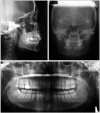Orthodontic treatment of gummy smile by maxillary total intrusion with a midpalatal absolute anchorage system
- PMID: 23814710
- PMCID: PMC3694207
- DOI: 10.4041/kjod.2013.43.3.147
Orthodontic treatment of gummy smile by maxillary total intrusion with a midpalatal absolute anchorage system
Abstract
This article describes the orthodontic treatment of a 31-year-old Korean female patient with gummy smile and crowding. The patient showed excessive gingival display in both the anterior and posterior areas and a large difference in gingival heights between the anterior and posterior teeth in the maxilla. To correct the gummy smile, we elected to intrude the entire maxillary dentition instead of focusing only on the maxillary anterior teeth. Alignment and leveling were performed, and a midpalatal absolute anchorage system as well as a modified lingual arch was designed to achieve posterosuperior movement of the entire upper dentition. The active treatment period was 18 months. The gummy smile and crowding were corrected, and the results were stable at 21 months post-treatment.
Keywords: Adult treatment; Lingual; Orthodontic mini-implant.
Conflict of interest statement
The authors report no commercial, proprietary, or financial interest in the products or companies described in this article.
Figures

















Similar articles
-
Efficacy of Infrazygomatic Crest Implants for Full-arch Distalization of Maxilla and Reduction of Gummy Smile in Class II Malocclusion.J Contemp Dent Pract. 2021 Oct 1;22(10):1135-1143. J Contemp Dent Pract. 2021. PMID: 35197381
-
Correction of a gummy smile and lip protrusion by orthodontic retreatment with lingual appliances and temporary skeletal anchorage devices.Am J Orthod Dentofacial Orthop. 2021 Oct;160(4):603-616. doi: 10.1016/j.ajodo.2020.06.036. Epub 2021 Jun 30. Am J Orthod Dentofacial Orthop. 2021. PMID: 34215469
-
Effective approach for improving a gummy smile : Upward movement of the maxillary occlusal plane using midpalatal miniscrews and a modified transpalatal arch.J Orofac Orthop. 2024 May;85(3):167-180. doi: 10.1007/s00056-022-00417-3. Epub 2022 Aug 25. J Orofac Orthop. 2024. PMID: 36006416 English.
-
Non-surgical correction of gummy smile using temporary skeletal mini-screw anchorage devices: A systematic review.J Clin Exp Dent. 2021 Jul 1;13(7):e717-e723. doi: 10.4317/jced.58242. eCollection 2021 Jul. J Clin Exp Dent. 2021. PMID: 34306536 Free PMC article. Review.
-
Effectiveness and Personalized Approaches in the Correction of Gummy Smile: A Systematic Review of Orthodontic and Surgical Treatments.J Clin Med. 2024 Nov 14;13(22):6843. doi: 10.3390/jcm13226843. J Clin Med. 2024. PMID: 39597985 Free PMC article. Review.
Cited by
-
Effectiveness of Treating Vertical Maxillary Excess Among Non-growing Adult Patients With Skeletal Anchorage System: A Systematic Review and Meta-Analysis of Case Reports From 2008 to 2023.Cureus. 2024 Dec 30;16(12):e76625. doi: 10.7759/cureus.76625. eCollection 2024 Dec. Cureus. 2024. PMID: 39881939 Free PMC article. Review.
-
Lip repositioning with or without myotomy: a systematic review.J Korean Assoc Oral Maxillofac Surg. 2021 Feb 28;47(1):3-14. doi: 10.5125/jkaoms.2021.47.1.3. J Korean Assoc Oral Maxillofac Surg. 2021. PMID: 33632971 Free PMC article. Review.
-
The Influence of Gingival Exposure on Smile Attractiveness as Perceived by Dentists and Laypersons.Medicina (Kaunas). 2022 Sep 13;58(9):1265. doi: 10.3390/medicina58091265. Medicina (Kaunas). 2022. PMID: 36143942 Free PMC article.
-
Dynamics, Efficacies, and Adverse Effects of Maxillary Full-Arch Intrusion Using Temporary Anchorage Devices (Miniscrews): A Finite Element Analysis.Biomed Res Int. 2022 Oct 7;2022:6706392. doi: 10.1155/2022/6706392. eCollection 2022. Biomed Res Int. 2022. PMID: 36254137 Free PMC article.
-
Facial profile changes due to bone cement graft to manage the hyperactive muscles of the gingival smile.Dental Press J Orthod. 2020 Mar;25(2):44-51. doi: 10.1590/2177-6709.25.2.044-051.oar. Epub 2020 May 29. Dental Press J Orthod. 2020. PMID: 32490926 Free PMC article.
References
-
- Creekmore TD, Eklund MK. The possibility of skeletal anchorage. J Clin Orthod. 1983;17:266–269. - PubMed
-
- Kim TW, Kim H, Lee SJ. Correction of deep overbite and gummy smile by using a mini-implant with a segmented wire in a growing Class II Division 2 patient. Am J Orthod Dentofacial Orthop. 2006;130:676–685. - PubMed
-
- Lin JC, Liou EJ, Bowman SJ. Simultaneous reduction in vertical dimension and gummy smile using miniscrew anchorage. J Clin Orthod. 2010;44:157–170. - PubMed
-
- Hong RK, Sohn HW. Update on the Fujita lingual bracket. J Clin Orthod. 1999;33:136–142. - PubMed
-
- Hong RK, Kim YH, Park JY. A new customized lingual indirect bonding system. J Clin Orthod. 2000;34:456–460. - PubMed
Publication types
LinkOut - more resources
Full Text Sources
Other Literature Sources
